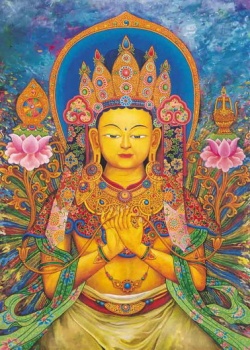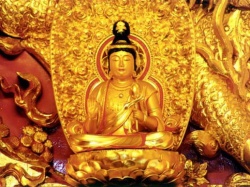The Yoga of the Inner Fire
A short introduction
The tradition known as The Six Yogas of Naropa is known in Tibet as Naro Choe Druk, meaning the six doctrines of Naro. It is however more correct to talk about six different yogas than doctrines due to the practical and concrete nature of the system. The six yogas are usually listed as: The Yoga of the Inner Fire, The Yoga of the Illusory Body, The Yoga of the Clear Light, The Yoga of transference of conciousness to a higher sphere, The Yoga of transference of conciousness to another body, and The Yoga of the Bardo.
The Six Yogas were formulated by the indian tantric Tilopa (988 – 1069) as a unification of the techniques he had learnt. Tilopas primary disciple, Naropa (956 - 1041), later perfected the system and initiated his own disciple Marpa (1012 - 1097) into it, who in turn brought the tradition to Tibet. The system has since then spread in different lineages and has become a living tradition in the whole of Central Asia. There are texts written by both Tilopa and Naropa still available today.
The practical aspects were traded down during the first centuries only by word of mouth. Naropa declared in his text Vajra Verses of the Whispered Tradition, where he talks about the six yogas, that
During thirteen generations this teaching should be sealed in secrecy as an oral transmission. It is the essence of all sutras and tantra and brings liberation to the fortunate
The word of Naropa was heeded, and the first who described the system in detail was Jey Tshongkhapa, part of the fourteenth generation in the lineage of initiation from Naropa. The two writings by Tsongkhapa are the primary sources for this text. Emphasis has been put on following Tsongkhapa's descriptions and structure of the practice as well as trying to make them accessible and less depending on the Tibetan cultural context.
The character of the system
The Yoga of the Inner Fire is the foundation of the other five yogas. The Yogas of the Illusory Body and the Clear Light together constitute the primary methods for enlightenment. The last three – the Yoga of transference of conciousness to a higher sphere and to another body and the Yoga of the Bardo – are primarily meant to be used as a last way out if the adept has not been able to reach illumination when physical death approaches.
The Six Yogas of Naropa is a typically tantric practice. A key distinction of tantra is the use of pleasure, enjoyment and the energy within one's own body. To practice tantra one should have mind founded in a pleased and content state of being and one should also be able to cope with pleasure without losing sense or control. The human body is an ever replenishing goldmine for the tantric practitioner; in fact it is his or hers most valuable asset.
According to the tantric tradition, the energies of pleasure are connected in a system of chakras; a subtle psycho-physical system of centers and channels. To be able to get strong results from the practice one must be acquainted with the chakra system and learn how to harness its powers. To build up a correct mindset and to begin to get an understanding of the chakras are the primary preliminaries, the very foundation on which the practice of the Six Yogas of Naropa is built. The Yoga of the Inner Fire is the technique with which we can begin to harness these resources and start manufacturing tantric gold. The Yoga of the Illusory Body and the Clear Light are then techniques dealing with how to use the energy that has been raised by the first yoga and how to focus and direct it to induce experiences that will produce enlightenment. When the monk Gampopa explained to Milarepa (the disciple of Marpa, in turn the disciple of Naropa) that he could sit seated in a deep samadhi for twenty days in a row, Milarepa replied:
That means nothing! It can not be compared with my Yoga of the Inner Fire.
The tantric way, especially the Six Yogas of Naropa, is quite special. A fullgrown master of usual meditation, such as Gampopa was when he encountered Milarepa, can through concentration reach a non-dual state of mind called samadhi. However, with the Yoga of the Inner Fire the tantric adept can combine such a state with a perfect state of happiness and pleasure. The result trancends all ordinary samadhi. The states cannot be compared.
After using the Inner Fire to reach a state of pleasurefilled non-dual wisdom the adept moves on to through the work with the Illusory Body and the Clear Light find a place for meditation during sleep and dreaming: the tantric brings the Inner Fire into the domains of sleep. The result is an explosion of Out-of-Body Experience and Lucid Dreaming. One will also acquire the knowledge of how to keep lucidity also in deep sleep. Through these techniques one reaches perfection in the state of illumination the Inner Fire has already brought one into contact with, and with continued practice one approaches complete illumination.
The system contains almost no element of intellectual understanding. Nor is any sort of religious belief and worship needed. The system is based on experience and is empirical. Practicing the techniques leads to results.


